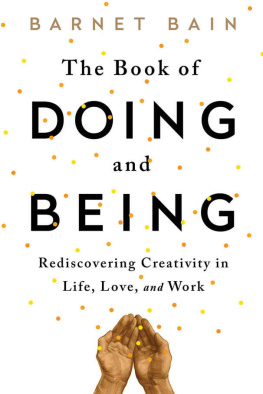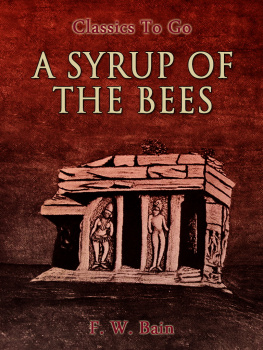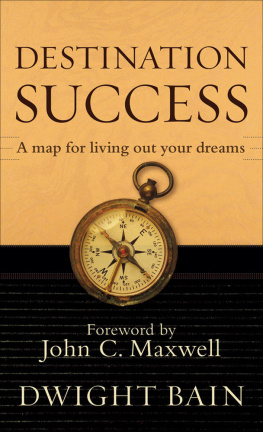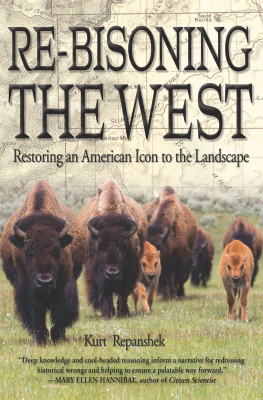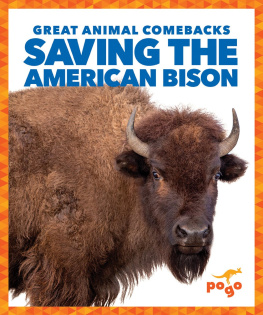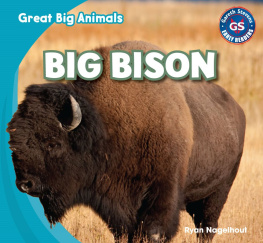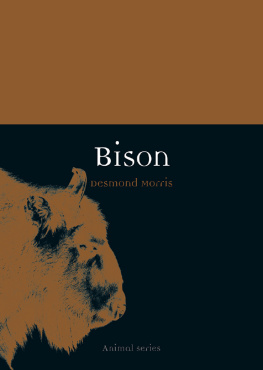BUFFALO GIRL COOKS

JENNIFER BAIN


CREDIT: RICK MACKENZIE
To the Bain-MacKenzie clan and the buffs

Contents
Chapter 1
Ground (Burgers + Balls)
Chapter 2
Ground (Beyond Burgers + Balls)
Chapter 3
Steaks
Chapter 4
Roasts
Chapter 5
Ribs/Shanks
Chapter 6
Sausages
Chapter 7
Odd Bits
At Home on My Range
We called him Blue Tag 741, for lack of a more personalized name. He was the first bison on our ranch in Alberta that I watched move from field to corral, then slaughter to freezer, and finally stove to stomach.
Blue Tag 741blue for boy, 741 denoting the year he was born (2007) and his number (41)was delicious in every way imaginable. His boneless blade roast became pot roast with chipotle-tomato sauce. His brisket was braised with pomegranate juice. His ground meat inspired endless burger and meatball experiments. Stewing meat was put to good use with Frito pie and wheat berry chili. Short ribs were braised with garlic and soy, dusted with ancho chili powder, slow-cooked with Guinness. When I didnt feel like cooking, there were steakstop sirloin, striploin, rib, tenderloin, skirt, flat iron (we love them all)panfried in a cast-iron skillet, usually with kosher salt and freshly ground black pepper, smoked paprika mayo on the side.
Ill spare you the offal details (tail, liver, heart, tongue, and, yes, testicles) except to say that meaty shanks, and femurs split and broiled for marrow are treasures that should never be discarded.
Blue Tags skull deteriorated naturally on a shed roof at our ranch. His hide was sent to a taxidermist. We ate most of his steaks, ribs, roasts, and odd bits ourselves, although our neighbors bought most of the jerky, sausages, and pepperoni made from his meat. It cost $1,428.63 to have Blue Tag slaughtered, cut, and wrapped at a small abattoir about an hour away from our southern Alberta ranch. I got to watch.
Blue Tag taught me a lot about ethical carnivorismabout meeting what you eat, caring enough to know how an animal is raised, and being respectful enough to eat every available part.

My Blue Tag 741 experience unfolded over 2008 and 2009, when I left my big-city food-writing job on maternity leave to play housewife/bison cook to my rancher husband. I fell hard for an iconic animal that has been brought back from near extinction by people eager to eat it. Now Im on a mission to convince everyone to love North Americas original red meat as much as I do.
Bison is a lean, wildly delicious alternative red meat that comes from heritage animals that are humanely raised and no longer endangered. You can raise bison, but you cant domesticate them. Theyre wild. They breed naturally. As ranchers like to say, you can lead a bison anywhere it wants to go.
Bison bison is the species name for the majestic herbivore with the shaggy brown coat and impressive hump. Buffalo is the romantic name, and the one my husband prefers. It confuses the heck out of most people, who think theyre two different animals. Bison, part of the bovine family along with domestic cattle, are related to the European bison (also known as wisent ). Dibs on the name buffalo also belong to the African Cape buffalo and the Asian water buffalo, which are different animals from our plains bison.
The nomenclature confusion dates back several centuries to the time when French explorers in North America referred to the animals as les bufs, as in oxen or cattle. English settlers changed that to la buff. The nickname evolved from there into buffalo.
The Canadian Bison Association ( CBA ) and the National Bison Association ( NBA ) in the United States want producers to help spread the word to consumers that bison is indeed the American buffalo they know and love. Or so the associations say officially. During a chat, NBA executive director Dave Carter admitted, I dont care what you call it as long as you eat it and enjoy it.
Like most people, I take the bilingual approach and switch easily between the terms. I favor buffalo for the animal and bison for the meat. When Im writing about First Nations people, who always say buffalo, I follow their lead.
I now live and work in Toronto, Ontario, and holiday at the ranch. Rick, my husband, works at the ranch and spends his holidays in Toronto. He always comes bearing suitcases full of meat. We own a lot of freezers.
At work, I write a food column called Saucy Lady. At the ranch, Im the Buffalo Girl. For this adventure cookbook, I hit the road to meet a bunch of buffalo people (or should I say bison people?), and I talked to others by phone.
This is our story. This is our food.

People always ask how a big-city journalist married a small-town rancher. Our mutual friend Adrienne set us up.
See, Rick is something of a city-slicker rancher. He grew up on a sheep/cattle ranch, but his parents, Ken and Margaret, encouraged Rick and his brothers, Colin and Norm, to pursue their own dreams. For Rick, that meant studying theater in Lethbridge and film in Toronto. He stayed in the city to indulge in his passions for music, film, art, coffee shops, and bakeries.
Me? I was born and raised in Toronto, studied journalism, and then wrote my way around Canada and Hong Kong before landing back in my hometown. I now write about food for the biggest newspaper in Canada and write cookbooks for fun.
When Rick and I met, we bonded over food. Here was a man who could bake a perfect apple pie and had a bison ranch. Rick kept an apartment in Toronto and commuted between worlds, learning to deal with the humped and horned herbivores that his brother Norm had introduced to the ranch in the 1990s. (The introduction of bison meant they could no longer raise sheep, because sheep can carry a disease that kills bison, so they dont mix. Rick still pines for lambs, his first animal love.)
Rick likes how bison are independent and dont need the intensive daily handling that other farm animals demand. They live outdoors and plow through the snow for food. Newborn calves stand within minutes and run within hours. We dont vaccinate our animals nor do we ever give them antibiotics.
Even if bison are hands-off animals, running a ranch is still a big jobthere are wheat and field-pea crops to plant and harvest, and theres always a fence to fix at MacKenzie Ranch.

Oh, give me a home where the buffalo roam,
Where the deer and the antelope play...
Who doesnt know this American poem-turned-song? I hummed it as a kid. I live it as an adult.
MacKenzie Ranch is 12,000 acres (4,860 hectares) of bucolic Great Plains and shortgrass prairie. But its not all flat, like youd imagine. There are broad, sometimes steep, eroded valleys called coulees, which were likely formed when the last glaciers retreated. The ranch is split into two properties. The main section, where we live in Ricks childhood bungalow, is in the Chin Coulee. The other half of the land is about 15 minutes down the road on the shores of Kings Lake in the Etzikom Coulee.
Next page

